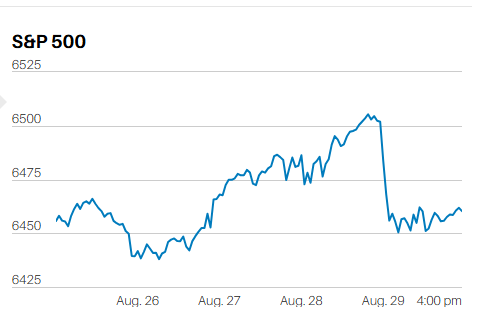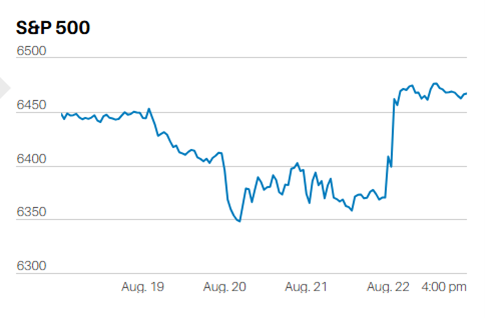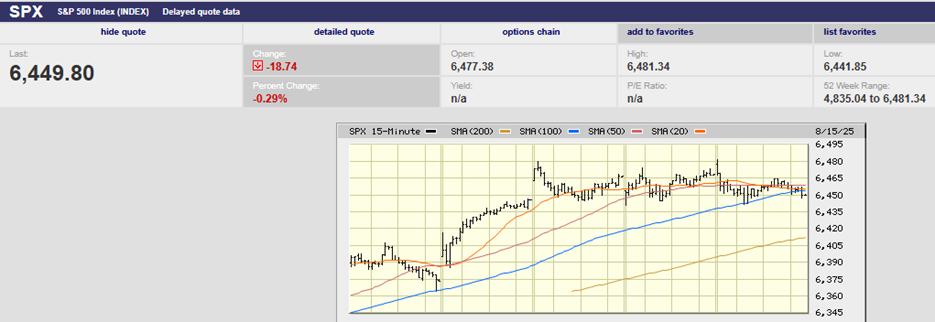Another 0.75% rate hike in September will happen

Market Update
The S&P 500 rose 0.4% last week to close at 4145.19. The Nasdaq rose 2.2%. The S&P hit its 4167.66 high for the week on Wednesday. There it ran smack into resistance as expected. It was unable to advance further on Thursday and Friday. Earlier this year the S&P spent eight trading days trying and failing to move higher from last week's levels. The index could only manage 4177.51 on June 2nd. A sell-off began on June 9th. Seven trading days later the S&P hit 3636.87. It was the index’s low for the year, reached on June 17th.
The S&P has climbed back to that stall zone. It is short-term overbought. The earnings season has gone better than expected. But a strong jobs report has the futures market pricing in more aggressive Fed tightening. The likelihood of another 0.75% rate hike in September has gone up to 65% from 28%. The jobs report came in at 528,000, double the forecast. There were upward revisions to the prior two months as well. Jobs are a lagging indicator. Jobs don’t peak until after a recession begins. Investors are not acknowledging that fact yet.
Also, the Federal Reserve is doubling the pace of Quantitative Tightening beginning in September. The QT process is not well understood. The Fed has only done it once before and then only for a short time. The increased pace of QT this fall is likely to bring more volatility with it. Quantitative Easing (QE) is credited with the stock market's ascension. Logically QT will bring about the opposite result. Inflation is running above 9% as measured by the CPI. It’s difficult to imagine the Fed will ease off the brake before it sees significantly lower inflation numbers.
It is possible we’ll see another sharp sell-off in the next few weeks. The sell-off may even test the June 17th low. The S&P needs to fall over 12% to do so though. It is more likely to happen over a longer period than the June sell-off. Perhaps by the second half of September or sometime in October. The next couple of weeks is more uncertain than normal. A continued move higher is unlikely before some profit taking, although still possible. More likely we’ll see selling take the S&P down to 3950-4000 before any further advance. It could hold there depending on the inflation numbers. More bad news on the inflation front would mean a further decline and a test of the June 17th low. Further weakening of the economy would also result in more downside for the stock market.
A continued move higher is also possible. The descending 200-day moving average is at 4350. The upper boundary of the descending trading channel is at 4350 as well. The S&P might continue to advance another 5% before running out of steam. Good news on the earnings and inflation fronts could get us there. A recession is coming though. Any move back to the 200-day moving average is going to be temporary.
The 2/10 yield curve is still inverted. The 10-year Treasury finished the week at 2.83%. The 2-year Treasury is at 3.24%. The 3-month Treasury has climbed to 2.55%. The Fed reportedly places more importance on the 3M/10Yr curve than the 2/10 in recession forecasting. The 3M/10Yr is moving toward inversion as well. Inversions don’t mean an imminent recession. It can take up to 18 months before one shows up after a yield curve inversion. Norwood Economics is still expecting a recession in 2023. The S&P 500 will most likely remain in a wide trading range until it begins pricing in a 2023 recession.
Economic Indicators
Manufacturing continues to grow. The S&P 500 manufacturing PMI was 52.2 in July and the ISM manufacturing index was 52.8%. Both indexes were essentially flat with the prior month. Factory orders were up, rising 2.0% in June after rising 1.8% in May. The service economy is also showing strength. The ISM services index was 56.7% in July up from 55.3% in June. Anything over 50% shows expansion. Core capital equipment orders rose 0.7% in June up from 0.5%. Core capital equipment orders indicate strengthening business investment.
The jobs market remains strong. Payrolls rose by 528,000 in July, far ahead of the expected 258,000 forecast. The unemployment rate fell to 3.5% and is at 50-year lows. Job openings declined to a still strong 10.7 million in June from 11.3 million in the prior month. The Quits rate held steady at 4.3 million. The Quits rate is the number of people leaving their job voluntarily. Presumably, people who quit their job are confident they can find another.
Borrowing is one potential sign of consumer stress. Nominal credit card debt increased 5.5% in Q2 up from negative 1.8% the prior quarter. As well real household debt rose 0.3% in Q2 after remaining flat in Q1. Consumer credit increased by $40 billion in June after rising $24 billion in May. Increased borrowing can mean consumer income isn’t keeping up with spending. Spending outstripping income isn't sustainable.
Overall, it doesn’t appear as if the U.S. is currently in a recession even though GDP has contracted two quarters in a row. The recession is still likely a 2023 event.
Understanding Performance (Again)
I had conversations with two clients last week about performance. Both conversations highlighted how little people understand about measuring performance. Both clients referenced dollar amounts instead of percentages. One client confused their June results with their year-to-date results.
One of the most common mistakes people make is tracking performance using dollars. It is common for a client or prospect to tell me that they’re down or up a certain amount of dollars on the year. I had a client tell me a few years back that they’d lost $40,000 in the last month. They were unhappy and wanted to know why. I told them I’d look into it and get back to them. Turns out they had lost a bit more than $40,000. Importantly, the loss was only 1.8%. It was a $2,200,000 portfolio. Meanwhile, the S&P 500 was down more than double that for the month in question. In other words, their performance had been good, not bad.
Last week I had a client email to ask me for a detailed explanation of why their portfolio was down on the year. I emailed back that their portfolio was down 8% on the year because we are in a bear market. I pointed out that the S&P 500 is down approximately 12% and the Nasdaq down approximately 19% on the year. The client is one of our few that is down on the year because they’re one of the few that was not in individual stocks. Norwood Economics has a handful of clients that are 100% index ETFs for various reasons. Index portfolios earn whatever the underlying asset class earns.
The other client who called me last week was focused on their June return, which was negative. They were surprised when I pointed out that they were up 3.5% on the year. Apparently, they were so focused on having lost $17,000 in their $290,000 portfolio (about 0.5% for the month) that they didn’t realize they were having a very good year compared to most investors.
Look at performance using percentages not dollars. Look at the same time periods. Make an apples-to-apples comparison of assets rather than trying to compare apples to oranges. It’s important to have an accurate understanding of your performance. Otherwise, it may lead to poor decisions.
Regards,
Christopher R Norwood, CFA
Chief Market Strategist











